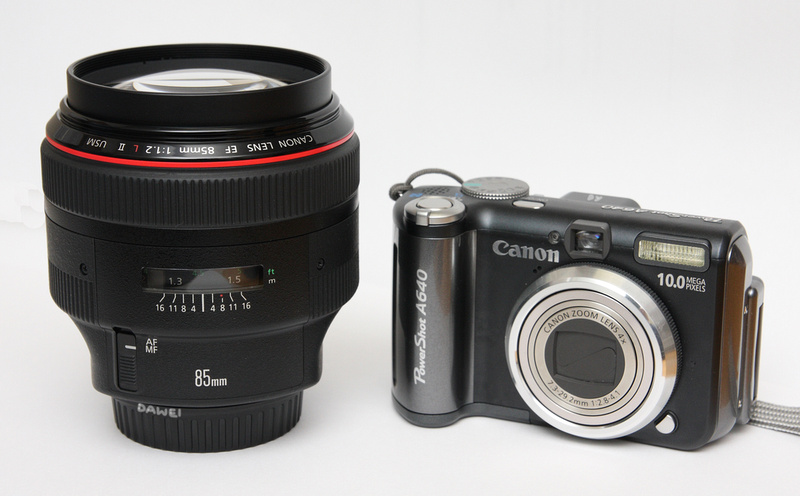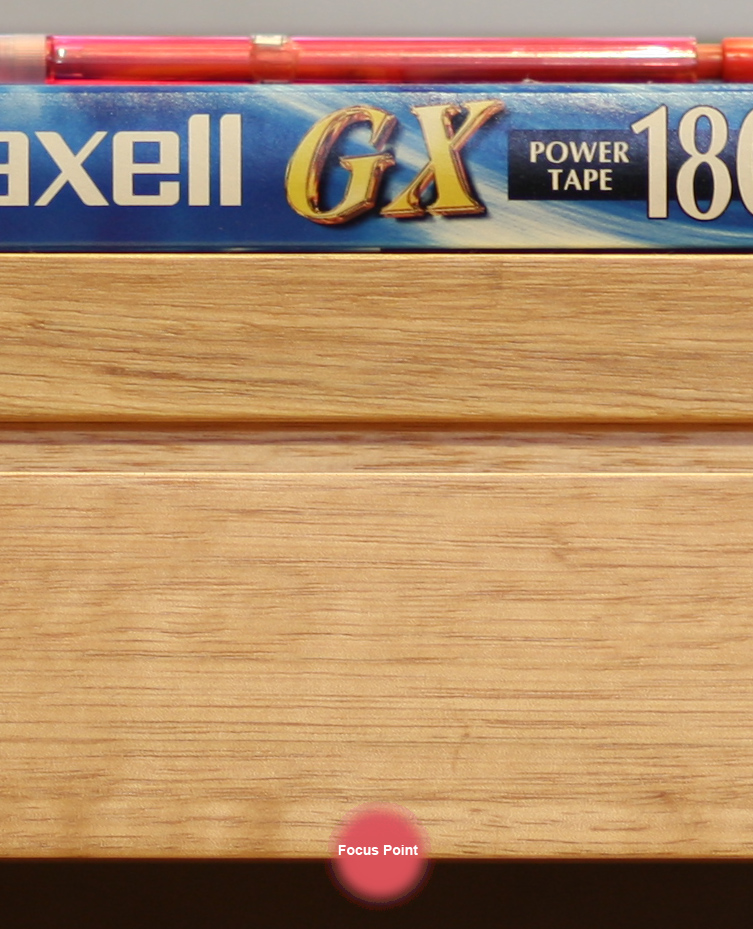Hi everyone, I'm new to this forum, so I thought I'd contribute something hopefully useful given the warm welcome I received. I have this mostly typed up anyway so it's no big deal. I haven't seen many reviews of this lens on a APS-C 1.6X crop factor sensor body, so here's my attempt at one. I use it on a 40D and a 400D.:
People say this lens was built for the 5D FF cameras (not literally, figuratively). Well, I haven't used it on a FF camera yet, so I'm sure I'll be in for a treat. I'll post another review when I get a 5D/5D2or 1Ds/1DsII/1DsIII
Here's a size comparison against a very large Point and Shoot, the Canon A640:
This lens is nicknamed "the grapefruit" or "the keg" or "the hand grenade" affectionately
Firstly, this lens has MANY, MANY problems:
1. Chromatic Aberration. Far out it's bad wide open. It tends to dissipate (is that the right word?) from about f/1.6 to f/1.8 onwards, but it is horrible in high contrast conditions and metal/chrome objects. Having said that though, it is rarely an issue in 99% of photos, and stopping down mitigates it. I can only vaguely remember one or two photos where the CA wrecked the shot, and those photos were test shots anyway where I wasn't properly exposing and composing. Just be careful and don't be afraid to stop down a bit (if you can) in bright high contrast conditions.
Check out this ISO 3200 crop on a chrome object:
HAHAHA, Put you off? No, don't leave, read on
2. If you have a 40D you might not want this lens. It has Battery Metering issues with 70-80% of Canon EOS 40D's (my estimate). Canon has acknowledged this issue but as of yet has not been able to solve the problem (or likely just sweeping it under the carpet given the 40D is now obsolete). Basically you will need to flick the off-on switch every 30 shots or so because of the battery will report "empty" incorrectly with this lens. Often a freshly charged battery will report empty before you even take one photo, so you'll have to do a off-on flick. Not all 40D's are affected - you may want to test out the lens on your 40D before buying if you are concerned.
3. Dust Pump. The inside of my rear element is full of fluff and dust after 6 months. Maybe my copy is unique in this regard, but it is an absolute dust magnet, and the extending front focusing design of the lens only contributes to this. Some report that it is easy to get dust off by unscrewing the rear mount and blowing off the dust, but the dust has not yet affected image quality so I think I'll leave it. I've gaffer taped the edges of the lens mount though because I think that's where the dust is going in.
4. AF: Not as slow as others say, but it is noticeably slow, especially if you are used to the blazing fast AF of the 70-200 lenses. This lens focuses nicely in low light on a 40D though, it doesn't tend to hunt that much. But mine hunts like crazy on a 400D in low light though.
Don't even think about using this for AI Servo in low light for a fast moving object, unless you have a Camera with awesome AF and you have good skills. AI Servo is usable in good light for something like bike rider, but in low light, the keeper rate is really low. (Doable in a pinch though). Note this is camera dependent too though.
5. Design Issues:
* Exposed Rear Element (basically level with the lens mount) - Although exposed and easily marked and soiled, it is quite tough to Canon's credit and scratches as of yet have not been permanent.
* Not Internally Focusing (only adds to the dust pump effect). When the lens focuses, the front extends, similar to the 50mm f/1.8 II.
* Focus By Wire (no MF if Camera is off) - what was Canon on when it gave the 85L this feature? It's especially bad for me because the 85L "just" fits in my bag's slot when its retracted, but if I forget to focus to infinity before dismounting the lens, I can't fit it in my bag Partially my fault yes, but I doubt many would miss the focus by wire feature.
* Canon did a Tokina and put the Mounting Indicator (red dot) on the back of the lens rather than the side It's a pain to mount this lens when you're under pressure, especially when you are also careful not to hit the rear element on the camera mount (because the rear element is basically level with the lens mount)
* Focus ring is a bit wobbly
* Canon for Christmas please give me IS (Image Stabilization) on this lens, thank you!(Not if it compromises Image Quality though)
6. Some other aspects of this lens that are interesting:
* Focus Ring has a very large range, you will have to do a few twists to cover the entire range. Good and Bad depending on the situation
* If you need a Lowepro Lens Case for it, the Lowepro 4s will fit it with the hood attached. Thanks to Bryan from the-digital-picture.com for this info. It is a good fit, but a teeny bit hard to put in and out because it is a little tight with the hood on. If you don't use the hood, the lens will bounce around inside the case, so you might want a smaller case if you don't use the hood.
* The hood is a clip on, not a Bayonet Mount. The hood looks ugly (its round not petal) and is a bit flimsy compared to the lens.
You know what, despite these issues, this lens still gets a highly recommended 5 stars out of 5 from me. This lens and its predecessor are legendary lenses, held with awe and reverence, and its status is well deserved.
An often asked question is "Why Canon over Nikon". Many photographers quote a simple word: 85L
The stuff you can do with this lens is just spectacular. Don't expect this lens to substitute for photography knowledge, skill and good light, but if you have these ingredients and you add this lens, then you will be capable of awesome results. If you suck, you will still suck after buying this lens. You have to earn the right to get great images from this lens.
The Bokeh (Boke) is just heavenly. I am not talking about the amount of background blur, I am talking about the quality of the background diffusion. It's just buttery smooth.
Image Quality? No worries from a APS-C perspective. I don't even have to say much here. This lens is sharp wide open. The contrast at a 100% crop level (micro contrast is it called?) is a tad lower than when stopped down, but this is ok because with a bit of sharpening in Photoshop - WOW. This lens sharpens up VERY well. If you are concerned with the sharpness of your copy, carefully take a photo of a flat surface with detail using MF aided by 10X Live View. It should look sharp. If its hazy or blooming, then you either stuffed up the test or your lens is stuffed up.
Seriously, it's sharp wide open, at least on APS-C 10MP sensors. This is coming from a pixel peeper who inspects the 100% view for EVERY photo he takes. Yes it does improve when stopping down though, mostly through improved contrast. From about f/1.6 onwards, not much can touch this lens for sharpness.
Here's a crop with zero PP sharpening, this is straight out of the camera RAW converted except for my annotation:
The biggest limit on sharpness though is imposed not by the lens resolving power, but by motion blur, low DOF and AF errors and CA.
At the end of the day, I have listed a whole list of nitpicks I have with this lens, but you quickly forget them when reviewing the images you take with this lens
Again, a warning, this lens will not make you into a super photographer. You will need to put in the hard yards in learning and practice, and this lens is a tool that you can use to demonstrate the knowledge and skills you gain. Expect much hardship (dealing with motion blur especially if you are used to IS lenses, dealing with AF issues, inaccuracies, AF calibration) but eventually you'll get better and better with it.
Highly Recommended Lens!
Sample Photos:
This first example is three portrait shots from the first (and thus far only) wedding I did, merged into one photo for ease of display. These shots were taken wide open at f/1.2. Notice the quality of background diffusion (bokeh or boke) with this lens. It is just so soft, smooth and "buttery". Other lenses can achieve this level of diffusion, but not this quality of diffusion. Many confuse the magnitude/degree of diffusion (which is dependent on depth of field) with the quality of diffusion (bokeh). It is the quality of diffusion that the 85L II is a world class leader in.








 Thanks useful information:
Thanks useful information: 






 Reply With Quote
Reply With Quote Add To Bookmarks
Add To Bookmarks


